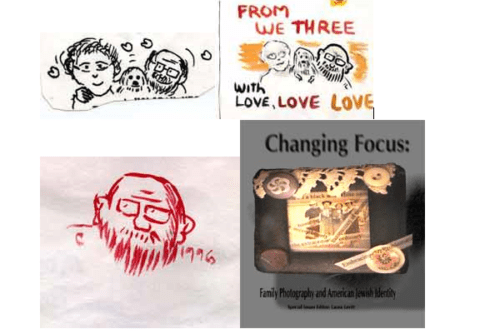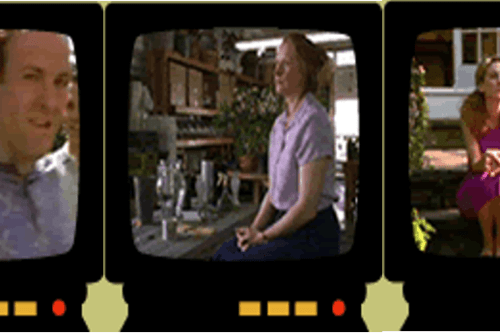And when I asked my mother if I
could have this album and she replied
this stays here in this apartment
until I die I glimpsed again the urgency
to be known.
–Irena Klepfisz, “Solitary Acts,” A Few Words
in the Mother Tongue, Portland, 1990.
Frames, Screens, Albums, Constructions: An Overview
This issue began as a kind of cross-genre exploration. It was to bring together family photographs and texts and to do so within the context of an Internet journal. As the issue began to come together all involved came to see the use of the Internet as an added benefit. It was going to allow us to include not only images and texts but to play with the capabilities of the net to reproduce moving images, to make links to already constructed websites and to enable the posting of a new website.

The cover image of this issue marks these intersections. It came as a gift from one of the contributors. Building around a small frame, my friend Ruth Ost put together this mixed media composition. The work includes, not surprisingly, an old snapshot, texts, as well as buttons and fabric capturing well the strange but beautiful mixture that is this special issue. In many ways, it too is a kind of handwork. Having not yet fully mastered all of the technologies that are tapped into, the essays here are pasted together, images and sound lovingly spliced into text and images. These are all the work of women, mostly Jewish women engaging with questions about their Jewishness in the realm of the quotidian, on the level of everyday life. They are works about home and family and traditions, and they are also works about friendship and other forms of intimacy. They ask questions about how we frame these relationships, asking us to look again at what is included or excluded from our own scrapbooks and photo albums. What do these images and traces of the past tell us about the present? The pieces gathered here ask these questions even as they extend these conversations. Here intimate images are both shared and juxtaposed in order to see what they might yield when we take them out of our family albums, where we know them best, and share them with a broader audience. And what happens when we frame these discussions around questions of American Jewishness?
In this sense, again the cover image is telling. As I learned from Ruth, the image at the heart of this construction is not of anyone she or I know. It was a snapshot purchased at a thrift shop in Paducah, Kentucky, the home of the Museum of the American Quilter’s Society (MAQS). This tiny image, approximately two by two inches, is from the 1930s or so. It is a group shot. There are four women all dressed up, each in a dandy hat and gloves. They have their arms around each other. It is not clear from this vantage point how old these women are, perhaps somewhere between 20 and 40. They are posed together in front of what appears to be a pond or lake. It is not clear who has taken this picture or how it wound up in a bin of other abandoned photographs in the shop in Paducah. For a few years, it remained in one of Ruth’s suitcases, waiting for her to find just the right place for it in one of her handiworks. Here what makes this image “Jewish” is my use of it to frame this issue. There is nothing “Jewish” about this piece otherwise. Nevertheless, the way the photograph gets reframed in this construction does suggest some other possibilities. More specifically, the fact that Ruth made this piece for me says other things about how it might be read or viewed.
Within the frame, at the top of the image printed on translucent paper, the text reads, “ode on a black and white image.” Here the words are made literal, or not quite. This is not “a lyric poem of some length.” Nor is it “a choric song of classical Greece, … accompanied by a dance and performed at a public festival or as part of a drama.” 1 It is, however, a visual lyric now a part of a different kind of public display. As the cover of this issue, it introduces a number of different kinds of ruminations on the question of American Jews and family photography. And both within and on its frame it suggests certain themes, questions and images. There is friendship, closeness between women who may or may not be kin. The image is old, and, as one of the text on its face suggests, there is something “haunting” about working with these kinds of images, some trace of a past no longer known but longing to be known. The labor of remembrance 2 is not an easy venture and what it yields is never neat. Instead, often what is produced is “a messy beauty.” Trying to find the telltale signs of those no longer in our reach is elusive. Their “signature transparent,” ephemeral. In these ways, the most ordinary can become extraordinary. These snippets of text have their own more intimate and more or less public echoes. They are part of a vocabulary Ruth and I now share. They are phrases familiar to those who know us, our students and our intimates. But, even so, the image at the heart of this piece remains just out of our grasp. The only thing we can control is the frame.
Here Ruth is literally all the more present. Atop the frame, draped and then pinned down by two buttons, is a piece of lace from her grandmother’s worn, crocheted bedspread – a piece of Ruth’s familial past, a tactile piece of her grandmother’s legacy. She was a woman who took in laundry and loved to crochet. This love of making things by hand is something she passed down to her granddaughter.
But this gift is also about a kind of sharing across differences. On the bottom right hand corner of the frame is another button. This one is covered by a small colorful swatch of paper – a pink and brown flower outlined in metallic gold that not only covers the ivory button but also holds in place another piece of text. Here, outside the frame, fragile, placed at an angle but still clearly a part of the whole piece, are more familiar words, “Embracing the Problematic.” These words echo the themes at the heart of my book, Jews and Feminism: The Ambivalent Search for Home 3, complicated embraces, odd juxtapositions, tensions that are at the heart of both contemporary Jewish feminist identities and our most intimate relationships. Moreover, these are the kinds of words used by a certain kind of feminist academic at the very end of the twentieth century and the beginning of the twenty-first. These are the only words that begin with capital letters and the only words outside the frame. Positioned on the frame, they ask us to read, to see the entire work with them in mind. They are, in this sense, a kind of textual framework.
Not to push the analogy too strongly, these things are never so neat, but it was this piece that enabled me to imagine this issue in all of its messiness, short pieces with images, images with few words and a soundtrack, a website, some traditional essays, all works by women who have become colleagues and friends often through their interactions with and through each other. If this issue, unlike Ruth’s gift, could fit in my hands, its edges would also be rough. Like Helène Aylon’s sacred text, it too might be viewed as “a book that will not close.” The entries are oddly juxtaposed and themselves unconventional. They hold together more like a scrapbook than a photo album. And, given the wonders of the Internet, unlike the album Irena Klepfisz writes about, this text need not be confined to just one physical location but here too is “the urgency to be known.” Online the images over Michelle Citron’s desk can float in and out of my computer screen alongside the words of Irena Klepfisz and pieces of Joanne Leonard’s extraordinary scroll. Readers/Viewers can click onto “Collected Visions” as they read about Lorie Novak’s work in Marianne Hirsch’s essay. They can listen in on a conversation about the film Yidl in the Middle as they go on to read Ruth Ost’s letters to Helène Aylon. This scrapbook need not stay in one place; it can be shared even as its actual physical contents remain in our individual hands. In this less material way, perhaps, “the urgency to be known” can be shared, at least some glimpse of that desire and, in the process, it may be possible to learn something new about American Jews from these all too everyday things.
- The American Heritage Dictionary Fourth Edition, s.v. “Ode.”[↑]
- This haunting and evocative phrase comes from Michelle Friedman. It is the title of her extraordinary dissertation about Next Generation Holocaust Narratives, “Reckoning with Ghosts: Second Generation Holocaust Literature and the Labor of Remembrance.” Diss. Bryn Mawr College, 2001.[↑]
- Laura Levitt, Jews and Feminism: The Ambivalent Search for Home, (New York: Routledge, 1997). See, for example, the table of contents.[↑]



